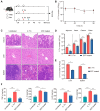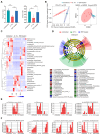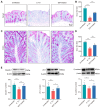Esculetin Combats Multidrug-Resistant Salmonella Infection and Ameliorates Intestinal Dysfunction via the Nrf2 Pathway
- PMID: 39456424
- PMCID: PMC11504508
- DOI: 10.3390/antiox13101170
Esculetin Combats Multidrug-Resistant Salmonella Infection and Ameliorates Intestinal Dysfunction via the Nrf2 Pathway
Abstract
The increasing incidence of multidrug-resistant (MDR) Salmonella enterica serovar Typhimurium (S. Tm), known for causing invasive enteric infections, presents a significant public health challenge. Given the diminishing efficacy of existing antibiotics, it is imperative to explore novel alternatives for the treatment of MDR S. Tm infections. Here, we identified esculetin (EST), a natural coumarin abundant in dietary foods and herbs, as a compound exhibiting broad-spectrum antibacterial properties against a range of MDR bacteria. Our findings demonstrate that EST effectively inhibited the proliferation and expansion of MDR S. Tm in both in vitro experiments and animal models. Specifically, EST significantly downregulated the type 3 secretion system-1 (T3SS-1) virulence expression of MDR S. Tm, thereby preventing its invasion into intestinal epithelial cells. In S. Tm-infected mice, we observed cecal injury characterized by the upregulation of inflammatory cytokines, a reduction in goblet cell numbers, a decreased expression of tight junction proteins, and microbial dysbiosis. Conversely, EST treatment ameliorated these pathological changes induced by S. Tm infection and reduced oxidative stress by activating the nuclear factor erythroid 2-related factor 2 (Nrf2) signaling pathway, thereby improving intestinal barrier function. These results suggest that dietary coumarins or a targeted plant-based diet may offer a promising strategy to counteract MDR bacteria-induced enteric diseases.
Keywords: Nrf2; S. Tm; coumarin; esculetin; intestinal barrier; multidrug-resistant (MDR).
Conflict of interest statement
The authors declare no conflicts of interest.
Figures







Similar articles
-
Chlortetracycline Enhances Tonsil Colonization and Fecal Shedding of Multidrug-Resistant Salmonella enterica Serovar Typhimurium DT104 without Major Alterations to the Porcine Tonsillar and Intestinal Microbiota.Appl Environ Microbiol. 2019 Feb 6;85(4):e02354-18. doi: 10.1128/AEM.02354-18. Print 2019 Feb 15. Appl Environ Microbiol. 2019. PMID: 30530706 Free PMC article.
-
A Novel Dibenzoxazepine Attenuates Intracellular Salmonella Typhimurium Oxidative Stress Resistance.Microbiol Spectr. 2021 Dec 22;9(3):e0151921. doi: 10.1128/Spectrum.01519-21. Epub 2021 Dec 1. Microbiol Spectr. 2021. PMID: 34851152 Free PMC article.
-
Salmonella enterica Serovar Typhimurium SPI-1 and SPI-2 Shape the Global Transcriptional Landscape in a Human Intestinal Organoid Model System.mBio. 2021 May 18;12(3):e00399-21. doi: 10.1128/mBio.00399-21. mBio. 2021. PMID: 34006652 Free PMC article.
-
Natural Coumarin Derivatives Activating Nrf2 Signaling Pathway as Lead Compounds for the Design and Synthesis of Intestinal Anti-Inflammatory Drugs.Pharmaceuticals (Basel). 2023 Mar 30;16(4):511. doi: 10.3390/ph16040511. Pharmaceuticals (Basel). 2023. PMID: 37111267 Free PMC article. Review.
-
Enteric Pathogens and Their Toxin-Induced Disruption of the Intestinal Barrier through Alteration of Tight Junctions in Chickens.Toxins (Basel). 2017 Feb 10;9(2):60. doi: 10.3390/toxins9020060. Toxins (Basel). 2017. PMID: 28208612 Free PMC article. Review.
Cited by
-
The role of plant-based dietary compounds in gut microbiota modulation in inflammatory bowel disease.Front Nutr. 2025 May 30;12:1606289. doi: 10.3389/fnut.2025.1606289. eCollection 2025. Front Nutr. 2025. PMID: 40521353 Free PMC article. Review.
-
Mechanisms of Keap1/Nrf2 modulation in bacterial infections: implications in persistence and clearance.Front Immunol. 2024 Dec 23;15:1508787. doi: 10.3389/fimmu.2024.1508787. eCollection 2024. Front Immunol. 2024. PMID: 39763664 Free PMC article. Review.
References
-
- Devlin J.R., Santus W., Mendez J., Peng W., Yu A., Wang J., Alejandro-Navarreto X., Kiernan K., Singh M., Jiang P., et al. Salmonella enterica serovar Typhimurium chitinases modulate the intestinal glycome and promote small intestinal invasion. PLoS Pathog. 2022;18:e1010167. doi: 10.1371/journal.ppat.1010167. - DOI - PMC - PubMed
-
- Lawrence A.-L.E., Abuaita B.H., Berger R.P., Hill D.R., Huang S., Yadagiri V.K., Bons B., Fields C., Wobus C.E., Spence J.R., et al. Salmonella enterica serovar Typhimurium SPI-1 and SPI-2 shape the global transcriptional landscape in a human intestinal organoid model system. mBio. 2021;12:e00399-21. doi: 10.1128/mBio.00399-21. - DOI - PMC - PubMed
-
- Stanaway J.D., Parisi A., Sarkar K., Blacker B.F., Reiner R.C., Hay S.I., Nixon M.R., Dolecek C., James S.L., Mokdad A.H., et al. The Global Burden of non-typhoidal Salmonella invasive disease: A systematic analysis for the Global Burden of Disease Study 2017. Lancet Infect. Dis. 2019;19:1312–1324. doi: 10.1016/S1473-3099(19)30418-9. - DOI - PMC - PubMed
Grants and funding
LinkOut - more resources
Full Text Sources
Research Materials

